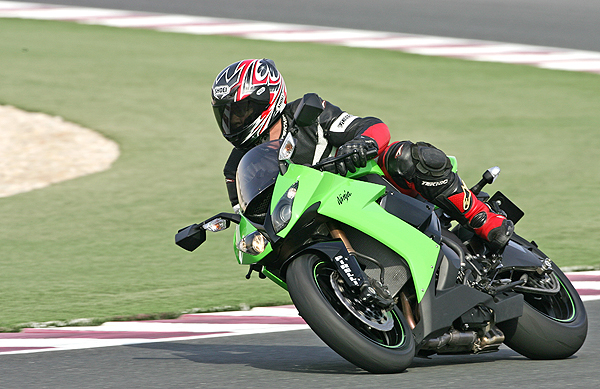
The circumstances had me concerned. Less than a month after crashing at another press intro (my fault), suffering a concussion and injuring my left shoulder (not to mention my sore ribs), I was on my way to the world press launch for the all-new 2008 Kawasaki ZX-10R in Qatar. Twenty-one hours of plane travel, and the jet lag associated with virtually turning your day upside down didn’t help. Nor did the fact that the beautiful Losail Circuit is notoriously slippery if you stray off the racing line (due to the constant presence of sand blown in from the surrounding desert). Add to this the fact I would be riding an unfamiliar, mega-horsepower motorcycle in a Muslim country (albeit, a relatively friendly one). The last thing I wanted to do was visit the hospital with a banged up, American body. I was more than a little tense.
While we stood as a group of American journalists in the first Middle Eastern airport (where midnight was noon in California, and visa versa), it was more than a bit surreal. After a steady diet of Muslim suicide bombings on television, I began to wonder whether I should have made this trip in the first place. Sensing the presence of a relatively large minority of European and Australian travelers, however, put me somewhat at ease.
Kawasaki was nice enough to fly us in a couple of days early so that we could transition a bit better to the local time zone. This helped, but my sore shoulder and aching ribs made it difficult to get a good nights sleep.
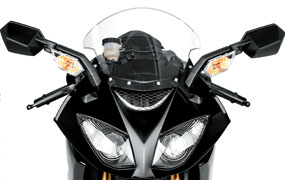
Two laps into my first session aboard the 2008 ZX-10R, I rolled through the second gear right-hander leading onto the front straightaway, stood the bike up, and wound the throttle to the stops. Tucked in over the tank, I was greeted by a low power wheelie that began at 103 mph, carried the front wheel for roughly a second and then rather nonchalantly placed it back on the tarmac. As the handlebars danced lightly in my hands, I glanced down at the very legible speedo to note the 103 mph figure. I was already comfortable enough with the new ZX-10R that I rather enjoyed the experience, and considered it a polite “hello” from the newest open class sportbike on the market. Despite being as fast as any bike I had ever ridden, I knew the ZX-10R would do exactly what I asked it to do — nothing more and nothing less. It was about this same time that I began to feel better about the whole trip, but I am getting ahead of myself.
There is plenty to discuss regarding the technical aspects of this all-new motorcycle. To begin with, Kawasaki’s development approach was relatively unique. Development started on the race track in the Japan Superbike series underneath former WSB race winner Akira Yanagawa. Kawasaki built a race bike, first. It then adapted that race bike to the street. In the motorcycle press, we like to use the phrase “race bike with lights”. This is the real deal.

The thing that stood out for me during our technical briefing at the Losail Circuit (that preceded our first ride on the bike), was the emphasis on top-end power. One of Kawasaki’s goals was to maintain low-end and mid-range power, and increase top-end. This made sense for a race bike, but it had me wondering just how usable that power might be. After all, the 2007 ZX-10R already packed quite a wallop up top.
In addition to increasing high rpm power, the Kawasaki engineers were tasked with increasing feedback to the rider, providing “track friendly ergonomics”, making the bike easier to change directions on, and developing extremely precise engine control (primarily through a re-designed fuel injection system and the KIMS system – Kawasaki Ignition Management System, discussed a bit later in this article).
The new backbone twin-tube frame was the subject of extensive testing and refinement. Ram air efficiency was increased significantly by opening up, and straightening the passageway around the head tube. In the process, Kawasaki somehow strengthened the head tube area of the frame. A resonator hole in the frame near the tail end of the ram air passageway is intended to reduce noise generated from the air box.
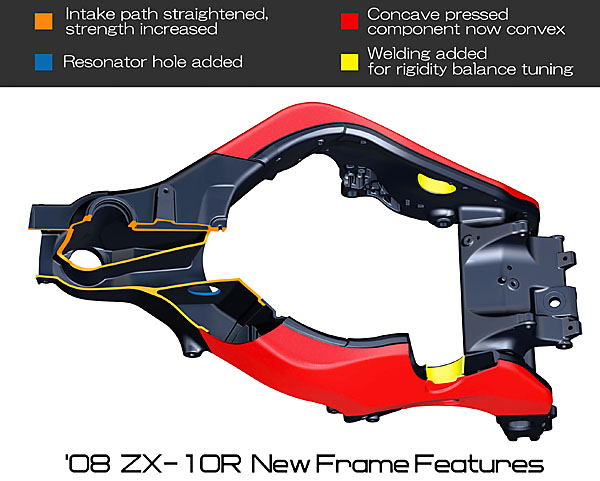
I had a chance to review notes taken by one of the Kawasaki engineers regarding significant features of the 2008 ZX-10R. I was not allowed to photocopy the notes, but I hand copied them verbatim (including the drawings). There was a very interesting note regarding the design of the backbone frame.
These notes showed that the frame rigidity was addressed, and tuned, in multiple sections from the head tube backward towards the swingarm pivot. Several frames were produced, and tested on the race track. At one point in the frame testing, a rider (presumably, Yanagawa) complained that there appeared to be too much frame flex near the center of the frame. Kawasaki took a unique approach to addressing this issue. It drilled through the frame, and inserted a pipe perpendicular to the frame rail, which was then welded in place. According to the engineer’s notes, this pipe was tried in three different positions before Kawasaki was satisfied that the final position was optimal from a handling perspective.

To further illustrate the somewhat obsessive approach to the new frame design, Kawasaki emphasized that certain pressed parts were created with a convex press process, rather than the concave process used in ’07. According to Kawasaki, this alleviated certain stress concentrations in the frame, and also assisted in the fine tuning of the frame’s rigidity.
The front portion of the new rear subframe is mounted directly to the frame’s upper cross member, which directs tire and suspension load more directly to the rider’s seat, enhancing feedback. The rear portion of that subframe is a separately bolted-on aluminum piece that can be easily removed when installing bodywork for racing.
Continuing with the feedback theme, frame rigidity was increased in the swingarm pivot area, and ribbing was added to the interior of the pivot plate where it joins the frame’s upper cross member. According to Kawasaki, this slightly slows down the feedback from the frame to the rider, giving the rider a better opportunity to determine what is happening at the rear contact patch.
Geometry-wise, the new frame is significantly different. The head pipe is moved 10 mm forward, and the rake of the front end is actually increased from 24.5° to 25.5°. The swingarm pivot was lowered 2 mm, and the swingarm itself is 2 mm longer. Overall, the 2008 ZX-10R has a wheelbase 25 mm longer than the 2007 model.

Suspension changes for 2008 include a new mounting location for the rear shock linkage, and a shock that now has dual compression damping (separately adjustable low and high-speed compression). The fork is a 43 mm unit with “diamond-like carbon” fork tube coating to reduce stiction. Both ends are fully adjustable (preload, compression and rebound damping), of course.
Kawasaki went back to dual brake pads for the front radial mount brake calipers, rather than the four individual pads used last year. The reason given was improved initial bite and better, more controllable progression. Discs are 310 mm this year (up from 300 mm), although they are lighter due to reduced thickness. Kawasaki claims reduced heat build up and less fade under heavy use (such as racing). Rotor carriers are aluminum this year for reduced unsprung weight. Out back is a single 220 mm disc gripped by a single-piston caliper.
Ergonomics for the new ZX-10R were designed for track performance. Body surfaces were intended to give the rider greater contact with the chassis in order to aide feedback. The narrower seat backs up against a newly designed, contoured seat back.
The engineer’s notes I reviewed indicate power at the crank is slightly lower in the low-end and mid-range, but equal to last year’s bike at the rear wheel (through some sort of reduction in parasitic losses). Top-end power, as stated, is claimed to be substantially increased. Kawasaki says peak horsepower is now 181 versus 175 last year. With the aide of ram air, peak horsepower on the new ZX-10R is a claimed 192 versus 183 last year. The bike has gained 8 pounds (a claimed 394 dry). Mass centralization is improved, however, in part by the replacement of the high-mounted, twin exhaust mufflers (under the seat last year) with a single muffler located lower and closer to the center of gravity. Kawasaki uses secondary fuel injectors (that kick in at 6,000 rpm) for 2008, oval throttle bodies (for increased flow) and reshaped intake ports. Together with a higher lift cam profile, Kawasaki achieved the increase in top end power.

To retain good throttle response down low, the exhaust valves were reduced in diameter by 1 mm. Exhaust ports were also reshaped, along with the combustion chamber. Compression increases from 12.7:1 to 13.0:1.
The bike again features a slipper clutch, but the transmission ratios are changed for 2008. Final drive is lower (17/40 is now 17/41), and first, fourth and fifth gear ratios are lower.
The most eye opening technology is the Kawasaki Ignition Management System (KIMS) that many journalists (including yours truly) described as “traction control” when Kawasaki first issued specifications for the 2008 ZX-10R. We were repeatedly told at the press intro that KIMS is “not traction control”. In truth, referring to KIMS as “traction control” is grossly oversimplifying things. The rider can still deliberately do burn outs and can spin up the rear tire on corner exits. The key word here is “deliberately”. KIMS is designed to prevent unintended, sudden increases in rpm levels (such as when hitting a slippery patch of oil with the rear tire on steady throttle).
KIMS is a very advanced, complicated system when you consider the number of parameters it monitors and interprets. Engine speed, throttle position, vehicle speed, gear position, feedback from intake air temperature, intake air pressure, engine temperature, O2 sensors, and change in engine speed are all considered by the ECU as part of the KIMS process. When KIMS “deems it necessary” ignition timing is slowed to curtail sudden spikes in engine rpm. Can this system prevent wheel spin from occurring? Yes, but not 100% of the time. It is not intended to do so, but only to aide the rider when wheel spin is unwanted.
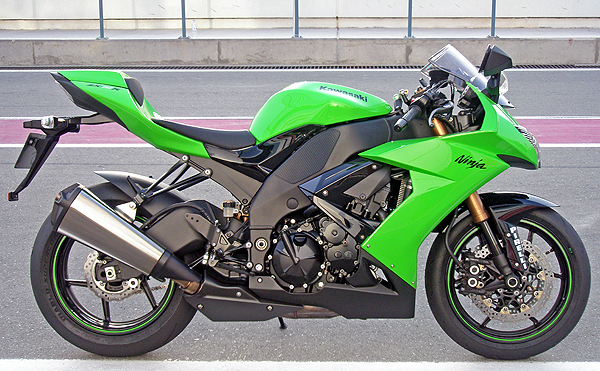
The 2008 ZX-10R features new styling, of course, and I like the look of the bike. It has an aggressive, sharp appearance, with some relatively hard creases. The only part I am unsure of is the exhaust muffler, which is huge. From the back, its angled shape is growing on me, however.
In the technical presentation before we rode the bikes, we were told that the crankshaft is a full kilo (2.2 pounds) lighter this year, but provided the same inertia. This confused a number of the journalists, but in reviewing the engineer’s notes it is clear that weight on the crank was shifted to the outer edge of its diameter, effectively increasing inertia at the same time overall weight has been reduced.

A very high quality, adjustable Ohlins steering damper is mounted just behind the triple clamps. I left mine in the standard position preset by Kawasaki during our testing, and found it acceptably permitted easy steering, but prevented excessive steering movement during wheelies. Purchased from the aftermarket, these dampers can cost anywhere from $300 to $500, and it is certainly a nice feature to have this factory-mounted on the stock machine.
I found the tach and speedo very legible on the new ZX-10R. Kawasaki has certainly learned its lesson. A few years ago, sport bike instrumentation was very difficult to read on Kawasakis. The new instrument face utilizes a special UV-blocking glass, which apparently decreases glare and increases contrast.
On the track, the ZX-10R felt balanced and easy to ride. Throttle response is as good as any bike I have ridden. This means the engine responds immediately to the throttle, but without any lurching or other unwanted response.
Low-end and mid-range power delivery is so smooth and linear it almost felt soft, at first. As the day wore on, however, and comparing notes with other journalists, power in this area felt more than competitive. Indeed, if Kawasaki is correct that low-end and mid-range power is virtually identical to last year’s model, then this Kawasaki will hold its own, and then some, at street rpm levels.
Power transitions smoothly and steplessly to an extremely potent top end. Although only 6/10ths of a mile long, the front straight at Losail produced top speeds of over 170 mph into a stiff headwind on Day 1 of testing. As the wind became more neutral on day 2, some journalists saw in excess of 180 mph on the ZX-10R’s speedometer. In summary, the 2008 ZX-10R has a fantastic engine — both extremely powerful, and extremely usable/controllable.
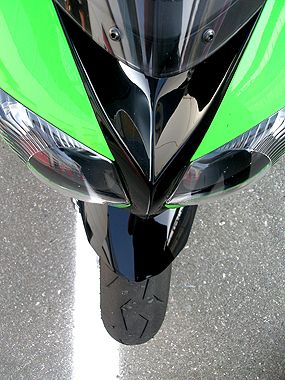
Whether KIMS played a part or not, the bike felt well hooked-up throughout our track test. We were aided in this respect by some superb Pirelli tires (that got even stickier on Day 2). Squat on acceleration and dive on hard braking were well controlled by the stock suspension settings despite the fact that this journalist undoubtedly outweighs the target sport rider. Indeed, the suspension was hard to fault. Losail is extremely smooth, so it is difficult to tell how the ZX-10R will handle small, choppy bumps on the street, but we were impressed with the damping on the track and the fact that both ends seemed to stay relatively high in the suspension stroke.
The ergonomics of the new ZX-10R also felt comfortable and roomy on the race track. This will undoubtedly translate into a pretty aggressive seating position on the street, but even an aggressive riding position can be comfortable if it is balanced correctly. The reach to the bars seemed very reasonable, and the pegs provide plenty of ground clearance without being overly high and cramping the rider. The seat shape, and the shape of the chassis parts touching the rider’s body, allowed me to move freely on the bike, while feeling an almost organic unity with the machine.
We couldn’t fault the new transmission ratios, either. The bike never felt like it was outside it’s useful powerband (perhaps, relatively easy for a 1000 cc machine to do), and the steps from gear-to-gear felt consistent.
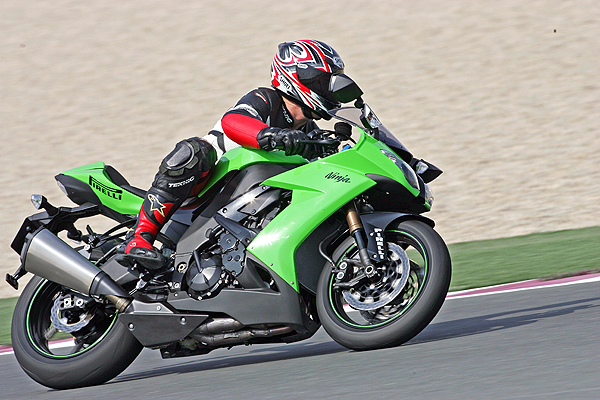
The 2008 ZX-10R definitely feels lighter, and more nimble than last year’s bike. Despite a longer wheel base, and geometry that would indicate the bike has moved towards more stable, ponderous handling, the new Ninja changes direction much easier . . . with much less effort. In the “engineer’s notes” referenced above, this was discussed directly. Despite the geometry changes, the bike is more nimble due to chassis rigidity tuning, according to Kawasaki’s engineers. Mass centralization and the re-positioning of the swingarm pivot (down 2 mm) help here, as well.
Whatever the reasons, the handling of the new ZX-10R is stellar. The bike is very predictable — doing exactly what you expect it to do, when you expect it. Quick and nimble, but stable at the same time. Deep into triple digit speeds on the front straightaway, the bike was easy to ride and the occasional swirling, strong side-winds caused little drama.
That all-important racing line at Losail was easy to follow on the ZX-10R. Mid-corner line corrections were easy, but the ZX-10R rarely required them — tracking the selected line faithfully.
This is as pure a race bike as you will find on the street, but wind protection is pretty reasonable for the sportbike category. A small lip at the edge of the front fairing is claimed to keep the rider a bit more comfortable, and it may be one of the reasons for a relative lack of buffeting affecting the rider during our test.
We did not find stronger initial bite from the front brake (if this is what Kawasaki meant in their tech presentation — we are not sure, frankly). Nevertheless, the front brake is plenty powerful and fade resistant. Brake feel did not impress us as being outstanding, but we would like to test the bike further where “shifting sands” is not a notorious aspect of the tarmac surface.
Vibration levels on the new ZX-10R are extremely low, and the bike has an overall refined, dialed feel to it. With KIMS doing its job in the background, that ultra smooth power delivery makes open class thrust a much friendlier and more potent ally, on the street or the track.

Does the 2008 Kawasaki ZX-10R represent a new high watermark in the open class? Our initial impression is more than positive, and it is hard to argue that it does not. Nevertheless, only side-by-side testing could confirm it . . . and Honda is about to step up to the plate with an all-new machine.
Despite this, my time spent aboard the 2008 ZX-10R has fundamentally altered my view of 1000 cc in-line, four-cylinder sportbikes. I had largely viewed such bikes as gross overkill, with excess power unusable by “mortal” riders. The new ZX-10R has changed that perception. What Kawasaki has created (not just with KIMS, but with the total package) is a super powerful friend that can be commanded with rheostat-like control . . . and not just by superman. The open class just became relevant, again.
For additional details and specifications, take a look at Kawasaki’s web site here. U.S. MSRP for the 2008 Kawasaki ZX-10R is $11,549. The bike is available in the U.S. in three colors, including Lime Green, Metallic Diablo Black, and Candy Plasma Blue.





